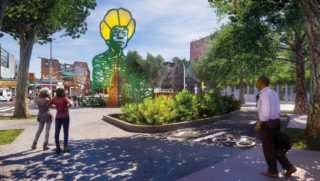“Multicultural can mean many things,” said Ryan Haddad, a 27-year-old playwright and performer. Haddad, who has cerebral palsy, holds a residency in the Emerging Writers Group at the Public Theater in Manhattan, where he has no problem getting around. He comes from the millennial generation often celebrated for its multicultural awareness, but which, more often than not, overlooks the disabled.
“Whenever somebody plans a party in Brooklyn—because that’s where you have the cool parties, the cool performances, the cool clubs, and the cool places to go—I often groan because it’s hard for me to get there,” he said. It’s not just diffcult for him as an audience member, he said, but also as a performer. When producers get behind a piece he’s written, they discuss access for him as well as for the audience, homing in on ADA compliance of nearby public transportation, which often falls short.

Haddad’s experience is one of many where infrastructure influences how communities form or fall apart. In other instances, housing and highways built by Robert Moses from the 1930s through the 1960s continue to sustain middle-class families far from Manhattan’s gleaming towers and Brooklyn’s farm-to-table restaurants. Old Jewish, Irish, and Italian neighborhoods are now home to Bengali hip-hop artists performing off the Bruckner Expressway, and Dominican writers holding readings in the shadow of the George Washington Bridge.
Bedroom communities that once housed white working-class families of police, firemen, nurses, and secretaries are now home to communities of color who have raised first-generation techies, artists, and activists—as well as police officers, firefighters, and executive assistants. These young New Yorkers, who have stayed on instead of moving out, are as much a part of Robert Moses’s legacy as the highways and bridges he built. They’re not looking for new neighborhoods closer to “The City” or Brooklyn—like their mid-century brethren, they just want to live close to Mom.
Likewise, there are the stalwarts who hunkered down when others headed out: the homesteaders of SoHo and the Italian butchers of Arthur Avenue. As E.B. White observed, there’s always “the person who was born somewhere else and came to New York in quest of something,” the settlers who give the city its passion.
Here’s a small sampling of natives and settlers who posed for photos and talked about how civic infrastructure and their neighborhoods have helped and hindered the multicultural city.
Keep reading:
> East Village, Manhattan: Ryan Haddad, Playwright and Performer at the Public Theater
2. SoHo, Manhattan: Charles Leslie, Founder of the Leslie-Lohman Museum of Gay and Lesbian Art, at the Museum
3. Arthur Avenue, the Bronx: Michael Rella and Peter Servedio, Butchers at Peter’s Meat Market, the Arthur Avenue Retail Market
4. Garment District, Manhattan: Nicola Caito and Camille Tetard, Patternmakers, at their Atelier
5. Grand Concourse, the Bronx: Basma Sheea, Bengali-American Singer, at the Andrew Freeman Home
4. Garment District, Manhattan: Nicola Caito and Camille Tetard, Patternmakers, at their Atelier
6. Grand Concourse, the Bronx: Elissa Carmona, Lead Singer and Founder of the Marrisania Band Project, at the Bronx Museum of the Arts
7. Washington Heights, Manhattan: John Paul Enfante, Writer and Teacher, at the Hispanic Society
8. Midtown, Manhattan: Ness McKelvey at Home
9. St. George, Staten Island: Bain Coffman and Gui Junta, Restaurant Owners at Chang Noi Thai
10. Astoria, Queens: Admir Ekmestic, Former Soccer Player, at Mrki’s Place ONLINE EXCLUSIVE
11. Astoria, Queens: Dee Flattery, Pub Owner at The Quay ONLINE EXCLUSIVE
12. Tomkinsville, Staten Island: Veronica Arze, Café Owner at Duzer’s Local ONLINE EXCLUSIVE

















